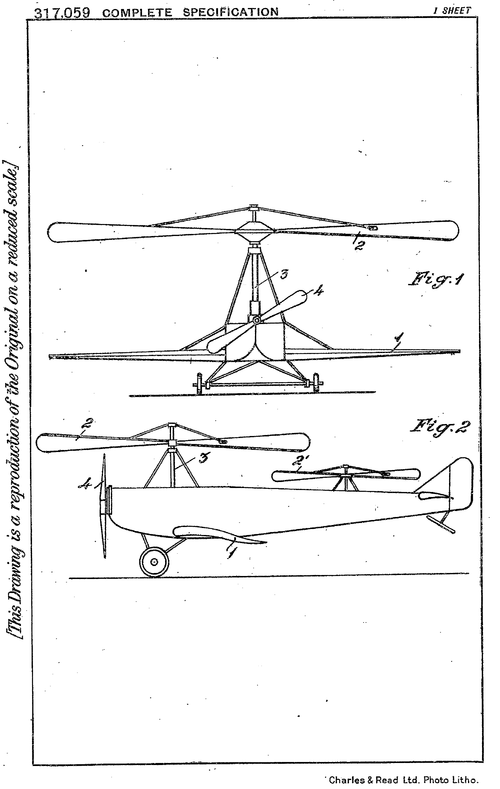Many great thanks to you Aerohydro,
and here is the translate for main part;
On September 24, 1930, a letter to Pope Pius XI leaves from the Pontifical Gregorian University. It is not just anyone who writes it. It is the Jesuit Padre Pio Scatizzi: professor at the Pontifical Gregorian University; associate astronomer of the Italian Astronomical Society (which in his bulletin recalled his death on 5 April 1956); correspondent of the Pontifical Academy of Sciences; mathematician, and author of books such as Solution of some kind of differential equation with any index,
The subject of Father Scatizzi's letter is the "gyro-helicopter" project, which the Jesuit would like to illustrate to the Pope. In short, this is the first helicopter project.
Father Scatizzi knows that the first congress of aviation law, convened in Budapest, is imminent, in which the Vatican plans to participate with its representative, the lawyer Angelini. The Jesuit therefore seems to have an opportunity to illustrate the qualities of his invention to the Pope. It is "a flight device that, in addition to safety, totally changes the old system". After three years of experimentation in the aerodynamics laboratories of Rome and Turin, the Milanese company Breda has agreed to build the new invention, given that the Italian government has allocated the sum of half a million lire for the launch of the experimental prototype.
"The gyroplane - writes Scatizzi to the pope - enjoys the rare property of flying over the vertical of the place, descending or stopping in mid-air, or, for the exchange of goods and mail, even at one meter from the ground, then quickly start again. . Besides, it is immune from the twist, so fatal, from wing slippage, from plummeting, even if, in any setting, it is surprised by an engine breakdown. "
Father Scatizzi foreshadowed the changes his invention would bring to aviation law.
"In fact, for example, the landing fields could be reduced to 50 square meters instead of a few square kilometers, while their location, as presently distant as the Littorio in Rome, the Flügafen [sic] in Berlin, the Burget in Paris can be welcomed in the city center, like any other train station. The fact of being able, with this device, to take off on the terraces of the houses and descend at their own leisure will not be exempt from legal modifications ".
Specific notifications to the buildings would certainly have been necessary, and telephone and telegraph cables would also have to be buried.
«Who can foresee all the consequences of the gyroplane already under construction? However, it seems to me appropriate that all this be made present in a first congress of this kind, and I also think it would be elegant and pleasant that in its first appearance, the Vatican, himself, would bring this historical note of originality and progress! "
Consequently, Father Scatizzi asked the Pope for consent to be able to accompany the Vatican delegate Angelini to the Budapest Conference, also in order to possibly integrate legal issues with technical ones.
«The Italian Government - he commented - sends six men. In short, I would like to present myself to Congress and point out this imminent realization and transformation, so that after so many efforts this year, we don't have to start over in 1931. Moreover, does the Holy Father not see in all this, for the Gyroplane in particular, a background of high missionary significance? "[1]
Father Scatizzi was not a visionary. His prototype of helicopter had been proposed by him to the Ministry of Aeronautics, which already on March 28, 1930 (with letter prot. 2/7264) had proposed to him none other than the stipulation of a contract for the supply of a specimen of “Giroplano Scatizzi”. But at a certain point Scatizzi kept the whole issue pending so much that Colonel Fiore, head of the Aircraft Division of the Ministry of Aeronautics (General Directorate of Construction and Supplies), with a new letter of 18 June 1930 had to urge the Jesuit inventor to move:
«This Ministry - Fiore wrote to him - is always waiting for the S.V. present himself for the agreements relating to the stipulation of the contract for the supply of the Scatizzi Giroplano. You will be pleased to receive a courteous communication about it. "[2]
Perhaps you understand the reason why Scatizzi had not yet turned up with the Ministry of Aeronautics. It was only on 21 June that he had sent the data relating to the helicopter project that he intended to carry out to the “Ernesto Breda Italian Society for Anonymous Mechanical Constructions of Milan”. Breda, for its part, had judged the data provided by the Jesuit "truly such as to justify your keen desire to arrive at a practical constructive realization, in truth, of the helicoplane itself", the project of which Breda therefore took a lot seriously.
But the realization times were long. The Company's technical department was "harassed by the development of other important projects", and could not at the moment take on new ones. "However - the director and the prosecutor of the First Section of Breda wrote to Scatizzi on 3 July 1930 - if the project of your helicopter had already been largely carried out, in the sense that there was a more or less complete series of construction drawings , even in detail, it would perhaps be possible that our company, subject to appropriate and clear agreements between us, also assumed to supply the Regia Aeronautica with a first copy. If you are willing to enter into this order of ideas, we would ask you to agree with our engineer Parano, whom you already know and who is there, so that you can take a look at the above-mentioned drawings and report to us, after which it will be our concern communicate our definitive decision regarding the collaboration that you are pleased to offer us. "[3]
We can only hypothesize the reasons for the hitch. Father Scatizzi had provided Breda with the technical data of his invention, but not the drawings of the helicoplane, perhaps because he hoped for a patent that the Society of Jesus could finance (years later, a similar case would have occurred for a particular type of safety belts, invented by another Jesuit father), and therefore thought it would not be prudent to disseminate his designs before obtaining a patent. The comparison between technical data and drawings would in fact have enabled Breda to mass-produce the helicopter itself in the absence of a patent held by its inventor, with intuitive effects for the parties involved, especially in the event of a successful prototype.
It must also be said that a well-planned agreement with Breda would have made it possible to build a prototype at least ten years before the Americans, after a systematic and adequate experimentation. But these are only hypotheses, ours.
After all, we do not know, as things stand, what conditions Breda intended to propose to his father Scatizzi, and if there was a subsequent negotiation. In his letter to the Pope of September 1930, the Jesuit mentions the willingness of Breda to build his invention and the appropriate allocation of five hundred thousand lire by the Italian Royal Government. What is certain, however, is that, at a certain moment, perhaps to obtain the funds for the patent from the Pope, Scatizzi intended to transform his helicopter into a "Vatican product" to be officially presented at the first Conference on aeronautical law in Budapest, of the Vatican (in his words) the bearer of a "historical note of originality and progress".
At the moment it is not given to us to know more. Dr. Novara, of Breda Energia spa (direct subsidiary of the Ernesto Breda Company), whom we thank here, told us that there is no Company archive; the relative papers would have been acquired by Finanziaria Breda Spa, which however no longer exists, while whoever currently holds the majority of the corporate package has nothing to do with the original family. Furthermore, in the House of Writers of the General Curia of the Society of Jesus it does not exist in the “Fondo Padre Pio Scatizzi”, since the Pontifical Gregorian University does not transfer its historical archive to the aforementioned House of Writers.
The historian's residual hope therefore rests on the possibility that the Gregorian University has its own archive and that this can be consulted by scholars, according to established rules and practices.

 groups.yahoo.com
groups.yahoo.com



